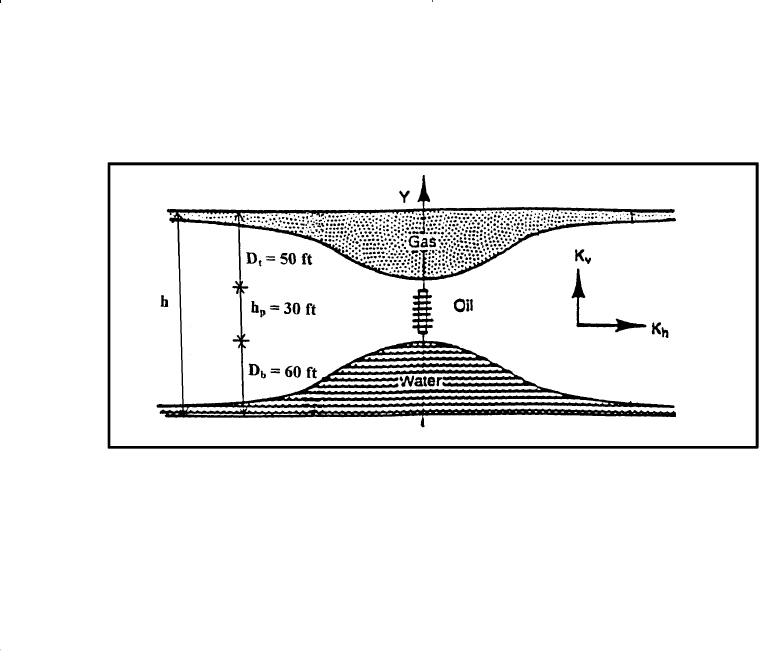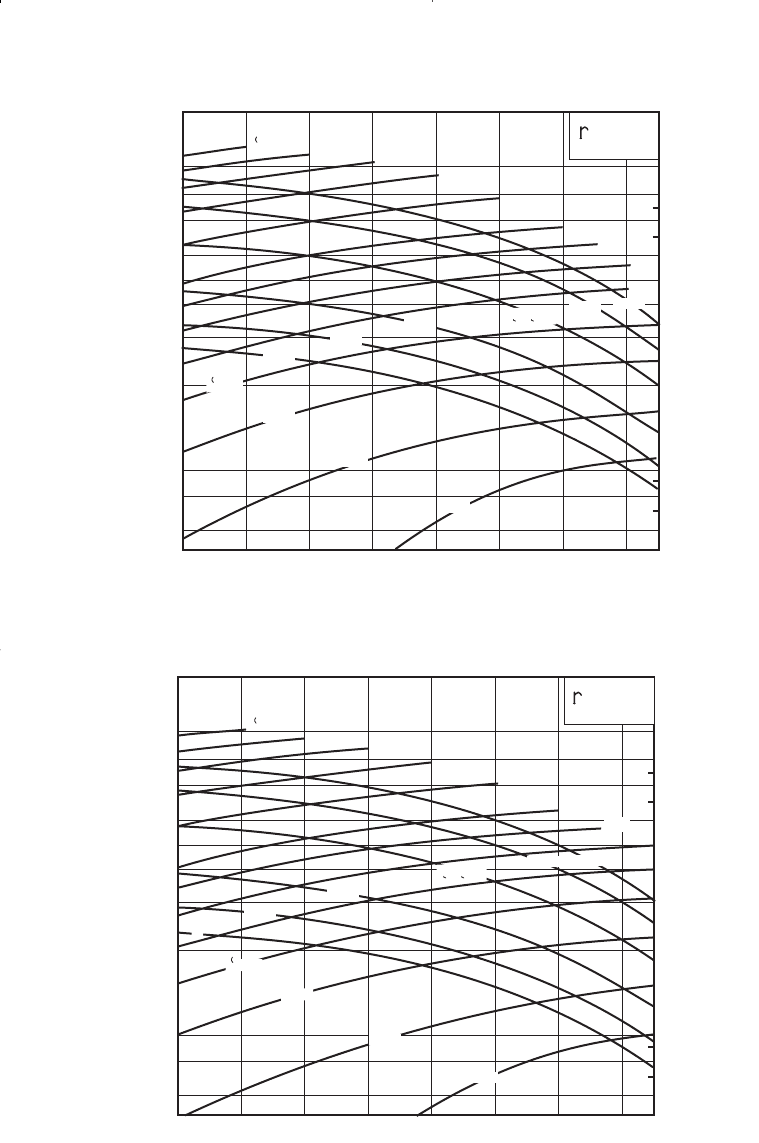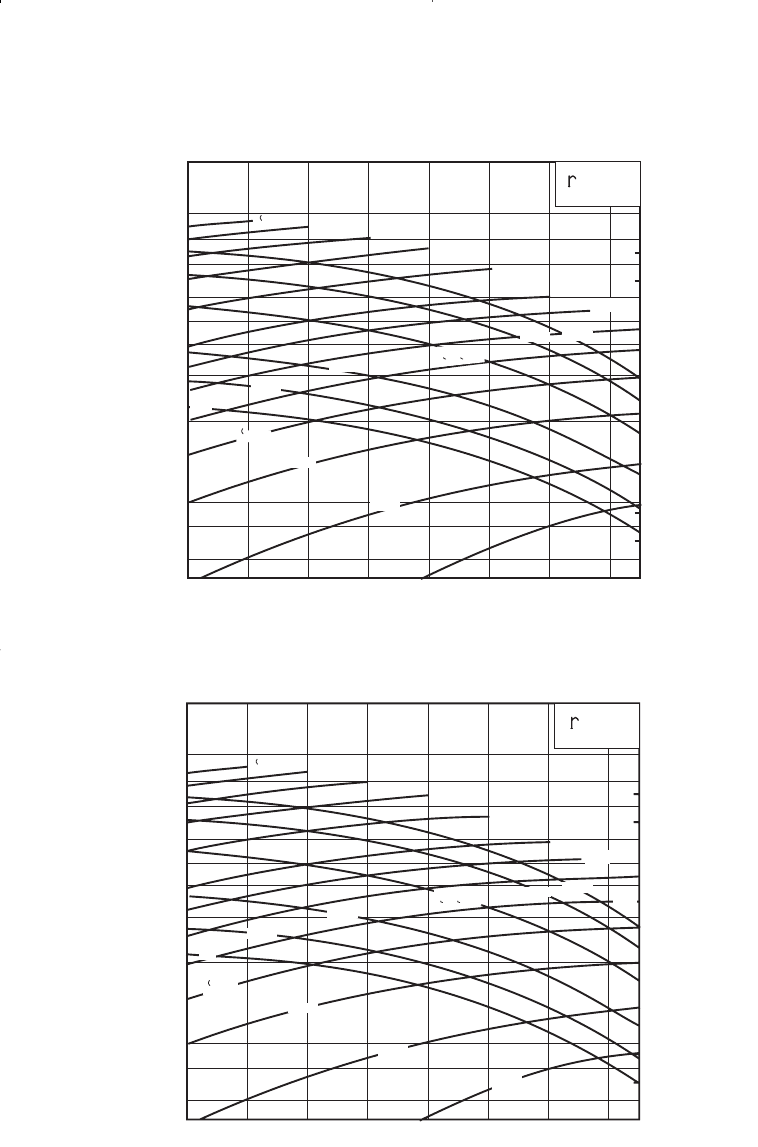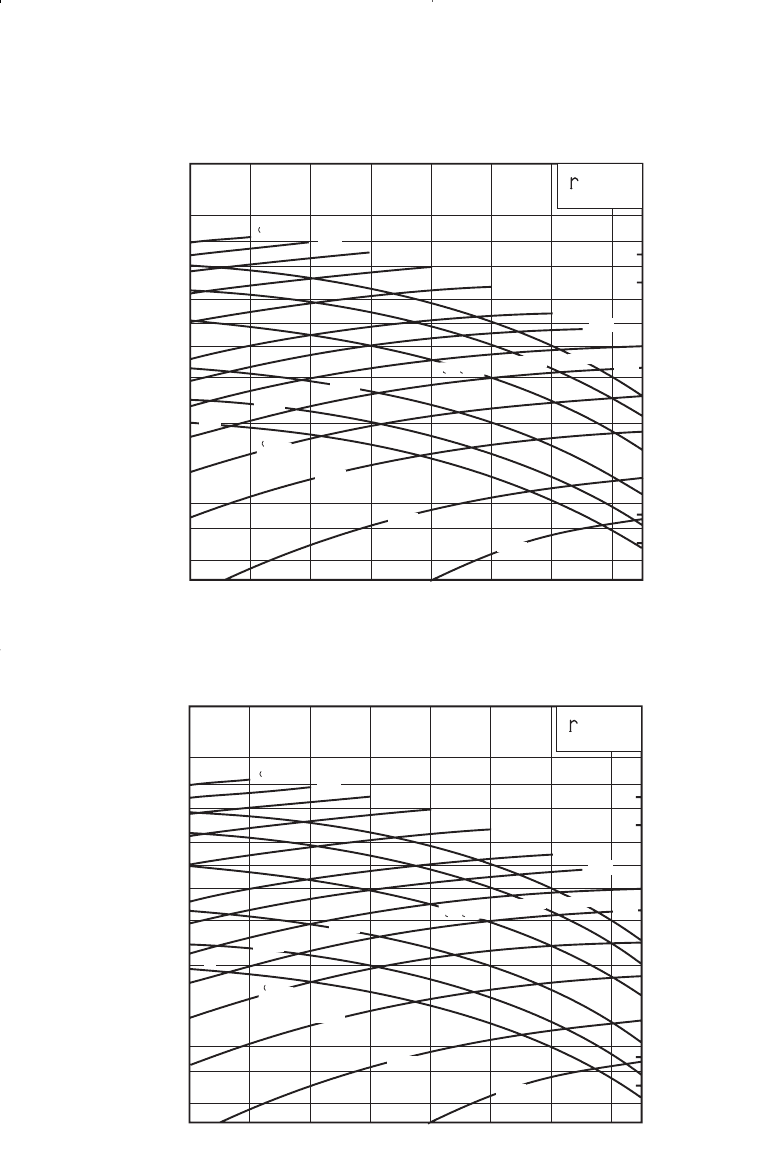Tarek Ahmed. Reservoir engineering handbook
Подождите немного. Документ загружается.


Step 1. Calculate effective oil permeability k
o
k
o
= k
ro
k = (0.85) (110) = 93.5 md
Step 2. Solve for Q
oc
by applying Equation 9-1
Example 9-2
Resolve Example 9-1 assuming that the oil zone is underlaid by bot-
tom water. The water density is given as 63.76 lb/ft
3
. The well comple-
tion interval is 15 feet as measured from the top of the formation (no gas
cap) to the bottom of the perforations.
Solution
The critical oil flow rate for this water-coning problem can be estimated
by applying Equation 9-2. The equation is designed to determine the criti-
cal rate at which the water cone “touches” the bottom of the well to give
The above two examples signify the effect of the fluid density differ-
ences on critical oil flow rate.
Example 9-3
A vertical well is drilled in an oil reservoir that is overlaid by a gas cap
and underlaid by bottom water. Figure 9-6 shows an illustration of the
simultaneous gas and water coning.
oc
2
2
oc
Q
= 0.246
63.76 47.5
l (660 / 0.25)
93.5
(0.73)(1.1)
40
15
Q = 8.13 STB/day
¥
-
È
Î
Í
˘
˚
˙
Ê
Ë
Á
ˆ
¯
˜
-
-
10
4
()
n
[]
oc
2
2
Q
= 0.246
47.5 5.1
l (660/0.25)
93.5
(0.73)(1.1)
40
(40 25)
= 21.20 STB/day
¥
-
-
-
-
10
4
n
[]
578 Reservoir Engineering Handbook
Reservoir Eng Hndbk Ch 09 2001-10-25 08:37 Page 578

The following data are available:
oil density r
o
= 47.5 lb/ft
3
water density r
w
= 63.76 lb/ft
3
gas density r
g
= 5.1 lb/ft
3
oil viscosity m
o
= 0.73 cp
oil FVF B
o
= 1.1 bbl/STB
oil column thickness h = 65 ft
depth from GOC to top of perforations D
t
= 25 ft
well perforated interval h
p
= 15 ft
wellbore radius r
w
= 0.25 ft
drainage radius r
e
= 660 ft
oil effective permeability k
o
= 93.5 md
horizontal and vertical permeability, i.e., k
h
, k
v
= 110 md
oil relative permeability k
ro
= 0.85
Calculate the maximum permissible oil rate that can be imposed to
avoid cones breakthrough, i.e., water and gas coning.
Solution
Apply Equation 9-3 to solve for the simultaneous gas- and water-con-
ing problem, to give:
Gas and Water Coning 579
Figure 9-6. Gas and water coning problem (Example 9-3).
Reservoir Eng Hndbk Ch 09 2001-10-25 08:37 Page 579

Pirson (1977) derives a relationship for determining the optimum
placement of the desired h
p
feet of perforation in an oil zone with a gas
cap above and a water zone below. Pirson proposes that the optimum dis-
tance D
t
from the GOC to the top of the perforations can determined
from the following expression:
where the distance D
t
is expressed in feet.
Example 9-4
Using the data given in Example 9-3, calculate the optimum distance
for the placement of the 15-foot perforations.
Solution
Applying Equation 9-4 gives
Slider (1976) presented an excellent overview of the coning problem
and the above-proposed predictive expressions. Slider points out that
Equations 9-1 through 9-4 are not based on realistic assumptions. One of
the biggest difficulties is in the assumption that the permeability is the
same in all directions. As noted, this assumption is seldom realistic.
Since sedimentary formations were initially laid down in thin, horizontal
t
D
= (65 15) 1
47.5 5.1
63.76 5.1
= 13.9 ft--
-
-
È
Î
Í
˘
˚
˙
tp
og
wg
D
=(h
h
)1--
-
-
È
Î
Í
Í
˘
˚
˙
˙
rr
rr
(9 - 4)
oc
22
2
Q
= 0.246
93.5
(0.73) (1.1)
65 15
(660 / 0.25)
(63.76 47.5)
+ (47.5 5.1) 1
47.5 5.1
63.76 5.
17.1 STB/day
¥
-
È
Î
Í
˘
˚
˙
¥-
-
-
Ê
Ë
ˆ
¯
È
Î
Í
--
-
-
Ê
Ë
ˆ
¯
˘
˚
˙
=
-
10
47 5 5 1
63 76 5 1
1
4
2
Ln
..
..
580 Reservoir Engineering Handbook
Reservoir Eng Hndbk Ch 09 2001-10-25 08:37 Page 580

sheets, it is natural for the formation permeability to vary from one sheet
to another vertically.
Therefore, there is generally quite a difference between the permeabil-
ity measured in a vertical direction and the permeability measured in a
horizontal direction. Furthermore, the permeability in the horizontal
direction is normally considerably greater than the permeability in the
vertical direction. This also seems logical when we recognize that very
thin, even microscopic sheets of impermeable material, such as shale,
may have been periodically deposited. These permeability barriers have a
great effect on the vertical flow and have very little effect on the horizon-
tal flow, which would be parallel to the plane of the sheets.
The Chierici-Ciucci Approach
Chierici and Ciucci (1964) used a potentiometric model to predict the
coning behavior in vertical oil wells. The results of their work are pre-
sented in dimensionless graphs that take into account the vertical and
horizontal permeability. The diagrams can be used for solving the follow-
ing two types of problems:
a. Given the reservoir and fluid properties, as well as the position of and
length of the perforated interval, determine the maximum oil produc-
tion rate without water and/or gas coning.
b. Given the reservoir and fluids characteristics only, determine the opti-
mum position of the perforated interval.
The authors introduced four dimensionless parameters that can be deter-
mined from a graphical correlation to determine the critical flow rates.
The proposed four dimensionless parameters are shown in Figure 9-7 and
defined as follows:
Effective dimensionless radius r
De
:
The first dimensionless parameter that the authors used to correlate
results of potentiometric model is called the effective dimensionless
radius and is defined by:
r
r
h
k
k
De
e
h
v
= (9 - 5)
Gas and Water Coning 581
Reservoir Eng Hndbk Ch 09 2001-10-25 08:37 Page 581

Meyer and Garder stated that the proposed graphical correlation is
valid in the following range of r
De
values:
5 ≤ r
De
≤ 80
where h = oil column thickness, ft
r
e
= drainage radius, ft
k
v
, k
h
= vertical and horizontal permeability, respectively
Dimensionless perforated length e:
The second dimensionless parameter that the authors used in develop-
ing their correlation is termed the dimensionless perforated length and is
defined by:
The authors pointed out that the proposed graphical correlation is
valid when the value of the dimensionless perforated length is in the fol-
lowing range:
0 ≤e≤0.75
Dimensionless gas cone ratio d
g
:
The authors introduced the dimensionless gas cone ratio as defined by
the following relationship:
e=hh
p
/(9-6)
582 Reservoir Engineering Handbook
Figure 9-7. Water and gas coning in a homogeneous formation. (After Chierici,
Ciucci, and Pizzi, courtesy JPT, August 1964.)
Reservoir Eng Hndbk Ch 09 2001-10-25 08:37 Page 582

with
0.070 ≤d
g
≤ 0.9
where D
t
is the distance from the original GOC to the top of perfora-
tions, ft.
Dimensionless water cone ratio d
w
:
The last dimensionless parameter that Chierici et al. proposed in
developing their correlation is called the dimensionless water-cone ratio
and is defined by:
with
0.07 ≤d
w
≤ 0.9
where D
b
= distance from the original WOC to the bottom of the
perforations, ft
Chierici and coauthors proposed that the oil-water and gas-oil contacts
are stable only if the oil production rate of the well is not higher than the
following rates:
where Q
ow
= critical oil flow rate in oil-water system, STB/day
Q
og
= critical oil flow rate in gas-oil system, STB/day
r
o
, r
w
, r
g
= densities in lb/ft
3
y
w
= water dimensionless function
y
g
= gas dimensionless function
k
h
= horizontal permeability, md
og
2
og
o
o
ro h g De
g
Q
= 0.492
h
()
B
(
kk
)(
r
,, )¥
-
-
10
4
rr
m
e
d
Y
(9 -10)
ow
2
wo
o
o
ro h
w
De
w
Q
= 0.492
h
()
B
(
kk
)(
r
,, )¥
-
-
10
4
rr
m
y
e
d
(9 - 9)
w
b
=
D
/h
d
(9 -8)
g
t
=
D
/h
d
(9 - 7)
Gas and Water Coning 583
Reservoir Eng Hndbk Ch 09 2001-10-25 08:37 Page 583

The authors provided a set of working graphs for determining the
dimensionless function y from the calculated dimensionless parameters
r
De
, e, and d. These graphs are shown in Figures 9-8 through 9-14. This
set of curves should be only applied to homogeneous formations.
It should be noted that if a gas cap and an aquifer are present together,
the following conditions must be satisfied in order to avoid water and
free-gas production.
Q
o
≤ Q
ow
and
Q
o
≤ Q
og
584 Reservoir Engineering Handbook
0.006
0.008
0.010
0.020
0.040
0.060
0.080
0.200
0.80
0.70
0.60
0.50
0.40
0.35
0.30
0.25
0.100
0 0.1 0.2 0.3 0.4 0.5 0.6 0.7
0.07
0.10
0.15
4
3
2
0.25
0.50
0=0.90
0=0.20
∆
og
∆
wo
=1
DE
=5
Figure 9-8. Dimensionless functions for r
De
= 5. (After Chierici, Ciucci, and Pizzi,
courtesy JPT, August 1964.)
(text continued on page 588)
Reservoir Eng Hndbk Ch 09 2001-10-25 08:37 Page 584

0.006
0.008
0.010
0.020
0.040
0.060
0.080
0.200
0.80
0.70
0.60
0.50
0.40
0.35
0.30
0.25
0.100
0 0.1 0.2 0.3 0.4 0.5 0.6 0.7
0.07
0.10
0.15
4
3
2
0.25
0.50
∆
og
0=0.90
DE
=10
∆
og
∆
wo
=1
0=0.20
Figure 9-9. Dimensionless functions for r
De
= 10. (After Chierici, Ciucci, and Pizzi,
courtesy JPT, August 1964.)
0.006
0.008
0.010
0.020
0.040
0.060
0.080
0.200
0.80
0.70
0.60
0.50
0.40
0.30
0.25
0.100
0 0.1 0.2 0.3 0.4 0.5 0.6 0.7
0.07
0.10
0.15
4
3
2
0.25
0.50
0.35
0=0.90
0=0.20
∆
og
∆
wo
=1
DE
=20
Figure 9-10. Dimensionless functions for r
De
= 20. (After Chierici, Ciucci, and
Pizzi, courtesy JPT, August 1964.)
Reservoir Eng Hndbk Ch 09 2001-10-25 08:37 Page 585

586 Reservoir Engineering Handbook
0.006
0.008
0.010
0.020
0.040
0.060
0.080
0.200
0.80
0.70
0.60
0.50
0.40
0.30
0.25
0.100
0 0.1 0.2 0.3 0.4 0.5 0.6 0.7
0.07
0.10
0.15
4
3
2
0.25
0.50
0.35
0=0.90
0=0.20
∆
og
∆
wo
=1
DE
=30
Figure 9-11. Dimensionless functions for r
De
= 30. (After Chierici, Ciucci, and
Pizzi, courtesy JPT, August 1964.)
0.006
0.008
0.010
0.020
0.040
0.060
0.080
0.200
0.80
0.70
0.60
0.50
0.40
0.30
0.100
0 0.1 0.2 0.3 0.4 0.5 0.6 0.7
0.07
0.10
0.15
4
3
2
0.25
0.50
0.35
0.25
0-090
0=0.20
∆
og
∆
wo
=1
DE
=40
Figure 9-12. Dimensionless functions for r
De
= 40. (After Chierici, Ciucci, and
Pizzi, courtesy JPT, August 1964.)
Reservoir Eng Hndbk Ch 09 2001-10-25 08:37 Page 586

Gas and Water Coning 587
0.006
0.008
0.010
0.020
0.040
0.060
0.080
0.200
0.70
0.60
0.50
0.40
0.30
0.100
0 0.1 0.2 0.3 0.4 0.5 0.6 0.7
0.07
0.10
0.15
4
3
2
0.25
0.50
0.35
0.25
0.80
0=0.90
0=0.20
∆
og
∆
wo
=1
DE
=60
Figure 9-13. Dimensionless functions for r
De
= 60. (After Chierici, Ciucci, and
Pizzi, courtesy JPT, August 1964.)
0.006
0.008
0.010
0.020
0.040
0.060
0.080
0.200
0.70
0.60
0.50
0.40
0.30
0.100
0 0.1 0.2 0.3 0.4 0.5 0.6 0.7
0.07
0.10
0.15
4
3
2
0.25
0.50
0.35
0.25
0.80
0=0.90
0=0.20
∆
og
∆
wo
=1
DE
=80
Figure 9-14. Dimensionless functions for r
De
= 80. (After Chierici, Ciucci, and
Pizzi, courtesy JPT, August 1964.)
Reservoir Eng Hndbk Ch 09 2001-10-25 08:37 Page 587
